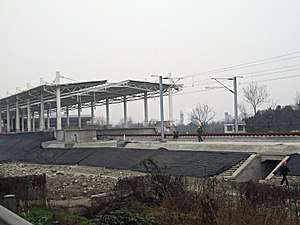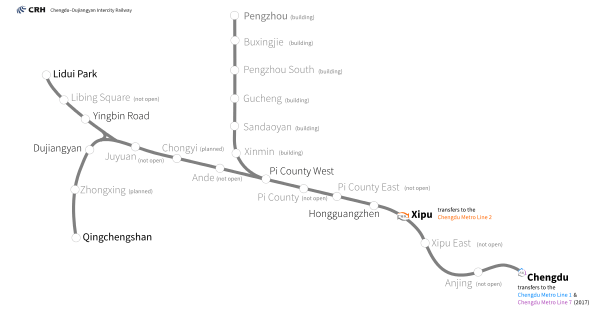Chengdu–Dujiangyan intercity railway
| Chengdu–Dujiangyan intercity railway 成灌铁路 | |||||||||||||||||||||||||||||||||||||||||||||||||||||||||||||||||||||||||||||||||||||||||||||||||||||||||||||||||||||||||||||||||||||||||||||||||||||||||||||||||||||||||||||||||||||||||||||||||||||||||||||||||||||||||||||||||||||||||
|---|---|---|---|---|---|---|---|---|---|---|---|---|---|---|---|---|---|---|---|---|---|---|---|---|---|---|---|---|---|---|---|---|---|---|---|---|---|---|---|---|---|---|---|---|---|---|---|---|---|---|---|---|---|---|---|---|---|---|---|---|---|---|---|---|---|---|---|---|---|---|---|---|---|---|---|---|---|---|---|---|---|---|---|---|---|---|---|---|---|---|---|---|---|---|---|---|---|---|---|---|---|---|---|---|---|---|---|---|---|---|---|---|---|---|---|---|---|---|---|---|---|---|---|---|---|---|---|---|---|---|---|---|---|---|---|---|---|---|---|---|---|---|---|---|---|---|---|---|---|---|---|---|---|---|---|---|---|---|---|---|---|---|---|---|---|---|---|---|---|---|---|---|---|---|---|---|---|---|---|---|---|---|---|---|---|---|---|---|---|---|---|---|---|---|---|---|---|---|---|---|---|---|---|---|---|---|---|---|---|---|---|---|---|---|---|---|---|---|---|---|---|---|---|---|---|---|---|---|---|---|---|---|---|
 | |||||||||||||||||||||||||||||||||||||||||||||||||||||||||||||||||||||||||||||||||||||||||||||||||||||||||||||||||||||||||||||||||||||||||||||||||||||||||||||||||||||||||||||||||||||||||||||||||||||||||||||||||||||||||||||||||||||||||
 A CRH1A high speed train at the Pi County West Station | |||||||||||||||||||||||||||||||||||||||||||||||||||||||||||||||||||||||||||||||||||||||||||||||||||||||||||||||||||||||||||||||||||||||||||||||||||||||||||||||||||||||||||||||||||||||||||||||||||||||||||||||||||||||||||||||||||||||||
| Overview | |||||||||||||||||||||||||||||||||||||||||||||||||||||||||||||||||||||||||||||||||||||||||||||||||||||||||||||||||||||||||||||||||||||||||||||||||||||||||||||||||||||||||||||||||||||||||||||||||||||||||||||||||||||||||||||||||||||||||
| Status | Operational | ||||||||||||||||||||||||||||||||||||||||||||||||||||||||||||||||||||||||||||||||||||||||||||||||||||||||||||||||||||||||||||||||||||||||||||||||||||||||||||||||||||||||||||||||||||||||||||||||||||||||||||||||||||||||||||||||||||||||
| Locale |
Chengdu and Dujiangyan Sichuan | ||||||||||||||||||||||||||||||||||||||||||||||||||||||||||||||||||||||||||||||||||||||||||||||||||||||||||||||||||||||||||||||||||||||||||||||||||||||||||||||||||||||||||||||||||||||||||||||||||||||||||||||||||||||||||||||||||||||||
| Termini |
Chengdu Qingchengshan Guanxian Ancient Town Pengzhou | ||||||||||||||||||||||||||||||||||||||||||||||||||||||||||||||||||||||||||||||||||||||||||||||||||||||||||||||||||||||||||||||||||||||||||||||||||||||||||||||||||||||||||||||||||||||||||||||||||||||||||||||||||||||||||||||||||||||||
| Stations | 21 | ||||||||||||||||||||||||||||||||||||||||||||||||||||||||||||||||||||||||||||||||||||||||||||||||||||||||||||||||||||||||||||||||||||||||||||||||||||||||||||||||||||||||||||||||||||||||||||||||||||||||||||||||||||||||||||||||||||||||
| Services | 1 | ||||||||||||||||||||||||||||||||||||||||||||||||||||||||||||||||||||||||||||||||||||||||||||||||||||||||||||||||||||||||||||||||||||||||||||||||||||||||||||||||||||||||||||||||||||||||||||||||||||||||||||||||||||||||||||||||||||||||
| Operation | |||||||||||||||||||||||||||||||||||||||||||||||||||||||||||||||||||||||||||||||||||||||||||||||||||||||||||||||||||||||||||||||||||||||||||||||||||||||||||||||||||||||||||||||||||||||||||||||||||||||||||||||||||||||||||||||||||||||||
| Opened | 12 May 2010 | ||||||||||||||||||||||||||||||||||||||||||||||||||||||||||||||||||||||||||||||||||||||||||||||||||||||||||||||||||||||||||||||||||||||||||||||||||||||||||||||||||||||||||||||||||||||||||||||||||||||||||||||||||||||||||||||||||||||||
| Operator(s) | China Railway High-speed | ||||||||||||||||||||||||||||||||||||||||||||||||||||||||||||||||||||||||||||||||||||||||||||||||||||||||||||||||||||||||||||||||||||||||||||||||||||||||||||||||||||||||||||||||||||||||||||||||||||||||||||||||||||||||||||||||||||||||
| Technical | |||||||||||||||||||||||||||||||||||||||||||||||||||||||||||||||||||||||||||||||||||||||||||||||||||||||||||||||||||||||||||||||||||||||||||||||||||||||||||||||||||||||||||||||||||||||||||||||||||||||||||||||||||||||||||||||||||||||||
| Line length | 94.2 km (59 mi) | ||||||||||||||||||||||||||||||||||||||||||||||||||||||||||||||||||||||||||||||||||||||||||||||||||||||||||||||||||||||||||||||||||||||||||||||||||||||||||||||||||||||||||||||||||||||||||||||||||||||||||||||||||||||||||||||||||||||||
| Track gauge | 4 ft 8 1⁄2 in (1,435 mm) | ||||||||||||||||||||||||||||||||||||||||||||||||||||||||||||||||||||||||||||||||||||||||||||||||||||||||||||||||||||||||||||||||||||||||||||||||||||||||||||||||||||||||||||||||||||||||||||||||||||||||||||||||||||||||||||||||||||||||
| Operating speed | 220 km/h (136.7 mph) max. | ||||||||||||||||||||||||||||||||||||||||||||||||||||||||||||||||||||||||||||||||||||||||||||||||||||||||||||||||||||||||||||||||||||||||||||||||||||||||||||||||||||||||||||||||||||||||||||||||||||||||||||||||||||||||||||||||||||||||
| |||||||||||||||||||||||||||||||||||||||||||||||||||||||||||||||||||||||||||||||||||||||||||||||||||||||||||||||||||||||||||||||||||||||||||||||||||||||||||||||||||||||||||||||||||||||||||||||||||||||||||||||||||||||||||||||||||||||||
The Chengdu–Dujiangyan intercity railway is a dual-track, electrified, passenger-dedicated, high-speed rail line in Sichuan Province, connecting the provincial capital, Chengdu with the satellite city of Dujiangyan. The line is 65 kilometres (40 mi) in length with 15 stations. China Railways CRH1 train sets on the line reach a maximum speed of 220 kilometres per hour (140 mph) and make the full-trip in 30 minutes. The line was built in 18 months and entered into operation on May 12, 2010. The railway is built to withstand an 8.0-magnitude earthquake. The Chengdu–Dujiangyan intercity railway has two branch lines : Pengzhou Branch line is 21.2 kilometres (13.2 mi) in length with 6 stations,[1] and Lidui Branch line is 6 kilometres (3.7 mi) in length with 3 stations.[2]
Route
The railway runs from the Chengdu Railway Station to Dujiangyan’s Qingchengshan railway station and passes through Pi County. Bridges and tunnels account for 67.8% of the line's total length. The longest viaduct is some 21 kilometres (13 mi). The line is built to withstand future earthquakes. Sound insulation panels were installed alongside the railway to reduce train noise near the tracks.[3] Clear panels allow passengers to enjoy rural scenery along this route.[3] The line shortened rail travel time from Chengdu to Dujiangyan by half, and will bring more tourist traffic to Dujiangyan’s World Heritage Sites, the city's ancient irrigation system and Mount Qingcheng, a sacred Daoist mountain.
 Chengdu–Dujiangyan high-speed railway under construction
Chengdu–Dujiangyan high-speed railway under construction- Chengdu–Dujiangyan high-speed railway's elevated tracks
Trains

The route uses CRH1 trains in eight-car train sets, which can carry 661 passengers.[5] Each day, 14 pairs of trains are scheduled daily between Chengdu and Qingchengshan Station, and 1 pair of trains are scheduled daily between Chengdu and Dujiangyan Station. 6 pairs start Chengdu Station and head up the Pengzhou Branch.
Stations

- Principal Line:Chengdu · Anjing · Xipu East · Xipu · Hongguangzhen · Pi County East · Pi County · Pi County West · Ande · Chongyi (planned) · Juyuan · Dujiangyan · Zhongxing (planned) · Qingchengshan
- Pengzhou Branch Line:Pi County West · Xinmin · Sandaoyan · Gucheng · Pengzhou South · Buxingjie · Pengzhou
- Lidui Branch Line:Juyuan · Yingbin Road · Libing Square · Guanxian Ancient Town
Prices
| Prices(¥) | Chengdu | Xipu | Hongguangzhen | Pi County West | Dujiangyan | Qingchengshan |
|---|---|---|---|---|---|---|
| Chengdu | - | 5 | 5 | 10 | 15 | 15 |
| Xipu | 5 | - | 5 | 5 | 10 | 10 |
| Hongguangzhen | 5 | 5 | - | 5 | 10 | 10 |
| Pi County West | 10 | 5 | 5 | - | 10 | 10 |
| Dujiangyan | 15 | 10 | 10 | 10 | - | 5 |
| Qingchengshan | 15 | 10 | 10 | 10 | 5 | - |
History
On May 28, 2008, 16 days after the Wenchuan earthquake devastated Dujiangyan and the western suburbs of Chengdu, the Chengdu city government and the Ministry of Railways agreed to build a high-speed railway line as part of the reconstruction of the disaster zone.[6] Construction began on November 4, 2008 and involved 20,000 workers at the cost of ¥13 billion.[3] The line entered trial operation on April 1, 2010 and full commercial operation began on May 12, 2010, the second anniversary of the large earthquake that killed some 70,000 people in the region.[3]
References
- ↑ 成灌“快铁”本月开工 建成后30分钟内到青城山 (in Chinese). China Railway. 2008-10-08.
- ↑ 半小时到彭州! 成灌快铁彭州支线明年通车 (in Chinese). 四川新闻网-成都日报. 2012-11-11.
- 1 2 3 4 Zhang Jiawei, "High-speed rail to bring in new era for Chengdu after quake" China Daily 2010-05-12
- ↑ "成灌快铁犀浦站正式开建". 成都市官方网站. 2009-08-26. Archived from the original on 2014-04-24. Retrieved 2013-08-08.
- ↑ (Chinese) "震后四川建首条城际快客 连通成都和都江堰" 新民晚报 2010-05-12
- ↑ (Chinese) "汶川震区首个灾后重建重大项目成灌快铁建设纪实" Xinhua 2010-05-12
External links
